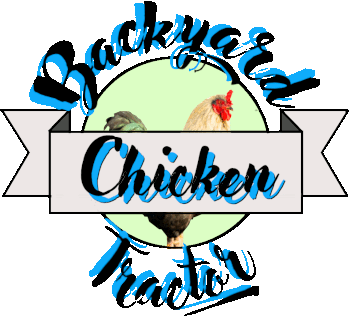For many of us, our first mental image of a chicken is a majestic white bird with a deep red comb and orange-yellow feet. There’s something nostalgic about having a few of these iconic chickens running around in your backyard chicken flock.
White chickens are also the chicken of choice for those who want to raise chickens for meat. It’s hard to pluck the smallest feathers which can make the carcasses of colored birds look hairy. White chicken breeds look a lot cleaner after plucking.
Whether you’re looking for good chicken for meat, eggs or just to look beautiful; you’ll be able to find a white chicken breed for your backyard. Here’s the Backyard Chicken Tractor blog team’s list of 11 white chicken breeds for your backyard flock.
White Leghorn
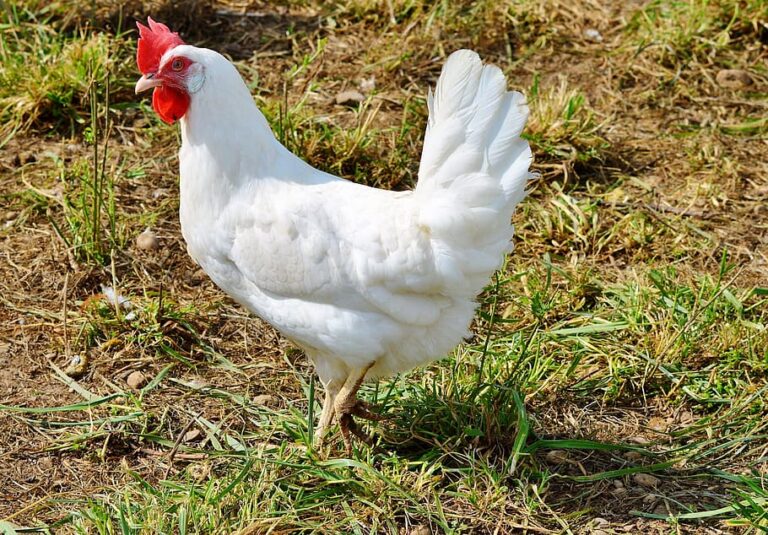
Purpose: Egg Layer
Weight: 5 – 6 lbs
Egg Production: 280 – 320 eggs a year
The White Leghorn is a classic backyard chicken. They were bred for their ultra-high egg production and they do a great job of putting food on the breakfast table. The popularity of the Leghorn started in 1835 when they came to the United States from Italy where they were known as Livorno. The version of the white chicken breed came to the States about 10 years later.
Unfortunately, the temperament of these egg-laying beauties is not the best. They can be flighty, nervous, and occasionally, aggressive. Despite their temperament, the White Leghorn takes to confinement well. They were, after all, bred as commercial chickens. They can make do with 3 square feet in the coop and 8 square feet in a chicken run. Of course, the White Leghorn chicken appreciates more.
Like many mid-sized white chicken breeds, the White Leghorn eats about 5 ounces of feed per day. However, it gives backyard chicken farmers an amazing egg output for that amount. The White Leghorn’s feed conversion makes it worth considering for any backyard flock.
White Ameraucana
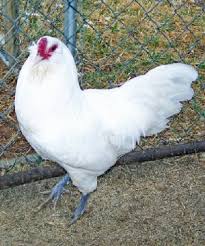
Purpose: Egg Layer
Weight: 5 – 6 lbs
Egg Production: 150 – 200 eggs a year
The Ameraucana’s roots date back as far as the 1500s in Chile where two native birds – the Collonca and the Quetero were bred to create the Araucana. The Araucana underwent selective breeding to remove a lethal gene in the 1920s and then, after crossbreeding with several different breeds, we got the Ameraucana.
White Ameraucanas lay beautiful blue eggs – one of the many reasons backyard chicken farms like to raise this white chicken breed. Another reason is that these docile chickens have a temperament that’s every bit as lovely as their blue eggs. They also weather the cold well (as long as they’re dry) and can handle warmer climates.
Backyard chicken enthusiasts wanting to keep the White Ameraucana will want to have around 5 square feet for their chicken coop and at least 10 square feet for a run.
Rhode Island White
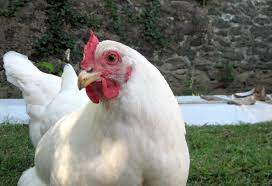
Purpose: Dual Purpose
Weight: 6 – 7 lbs
Egg Production: 200 – 250 eggs a year
The Rhode Island White is another white chicken breed with the classic look we love so much. This breed goes back to 1888 by crossing White Wyandottes, Partridge Cochins, and White Leghorns. Despite similarities in their names, the Rhode Island White and Rhode Island Red are not related.
Rhode Island Whites are excellent dual-purpose breeds. This white chicken breed makes a great addition to backyard chicken flocks. These chickens also have a friendly temperament and they readily adapt to a wide variety of climates and situations. They really are the utility player of the backyard chicken game!
These chickens can live with 5 square feet in their chicken coop and 10 square feet in a chicken run, but they love to forage and will appreciate the opportunity to range on occasion. If your chickens don’t forage for food, expect to feed them around 5 ounces a day.
White Faverolles
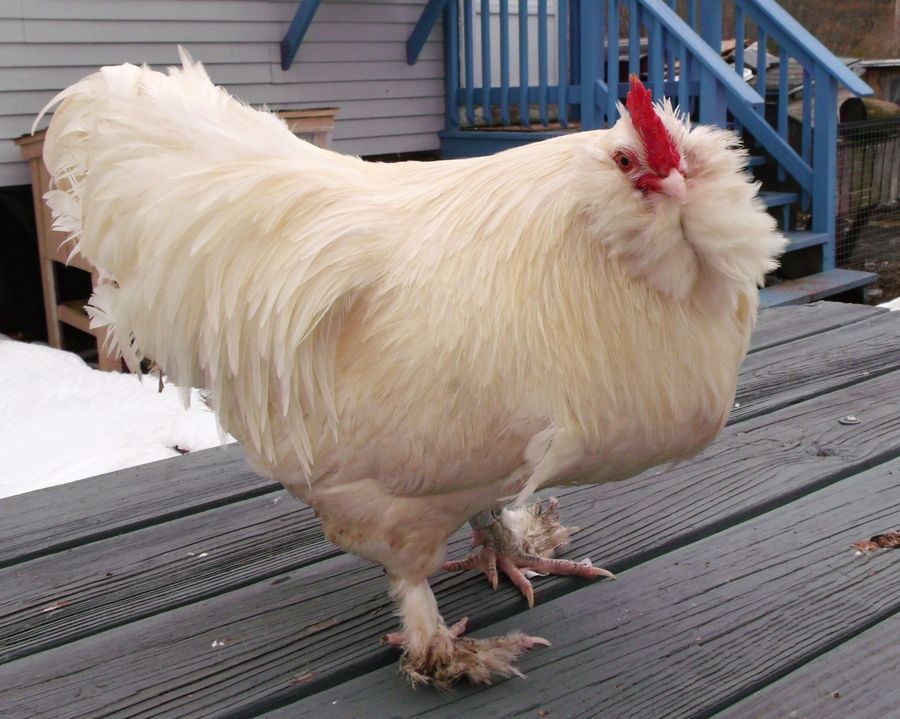
Purpose: Dual Purpose
Weight: 8 – 9 lbs
Egg Production: 200 – 250 eggs a year
LThe White Faverolles line of white chicken breeds started in France around the 1860s. Faverolles were bred by crossing Brahmas, Cuckoos, Dorkings, Flemish, French Rennes, Houdans, and Malines. Getting these timid beauties took some doing!
While the White Faverolles’ submissiveness can get them picked on in a mixed flock, it makes them amazing backyard chickens. They’re also great for chicken enthusiasts hoping to get their young kids interested in the hobby. These sweet, kooky-looking birds are irresistible.
White Faverolles do well in cold climates, but they aren’t very heat-hardy so keep that in mind when determining whether this is the right breed for you.
If you decide to keep White Faverolles, you should have around 5 square feet in the chicken coop and 10 square feet in a chicken run. They eat an average amount of feed and should be good with around 5 ounces of feed a day.
White Plymouth Rock
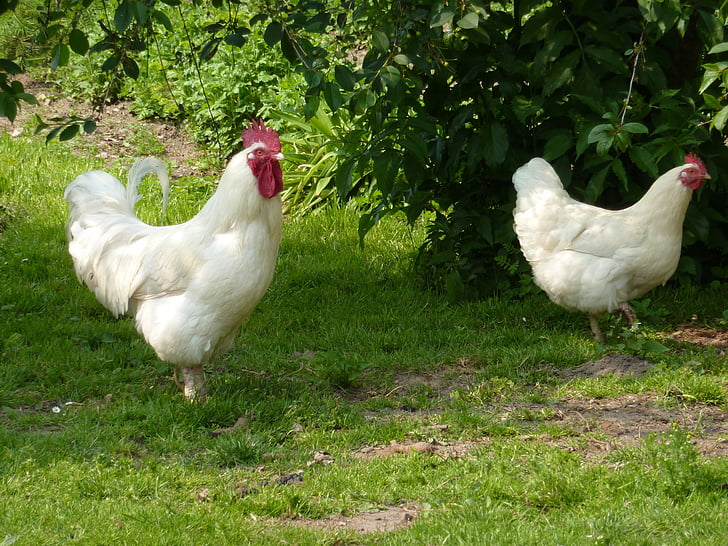
Purpose: Dual Purpose
Weight: 7 – 9 lbs
Egg Production: 200 – 280 eggs a year
The White Plymouth Rock was first bred in 1888 and came from selective breeding of the Barred Plymouth Rock. The Barred Plymouth Rock, in turn, was bred in 1865 by crossing a Dominique and a Black Cochin (or Black Java depending on who you ask). The White Plymouth Rock quickly eclipsed the Barred Rock in popularity and is now the foundation of commercial poultry production in the US.
White Rock chicken breed is a great choice for a backyard chicken flock. Not only are they exceptional dual-purpose birds, but they’re also cold-hardy and have a sweet, docile temperament. This white chicken breed can handle warmer climates as well.
The beautiful white feathers on a White Plymouth Rock are attractive to more than just people. The White Rock’s gorgeous feathers and easy-going temperament make it vulnerable to predators. Your coop should be well protected. These hens will need about 5 square feet in their coop and 10 square feet in their chicken run. Like hens of a similar size, the White Plymouth Rock will eat 4 – 6 ounces of feed a day.
-
DEStar 71” x 30” Foldable Outdoor Backyard Metal Coop Chicken Cage Enclosure Duck Rabbit Cat Crate Playpen Exercise Pen…
Chicken Runs $109.69Rated 0 out of 5 -
FDW 86” x 40” Chicken Coop Chicken Cage Outdoor Metal Pet Enclosure Pet Playpen Exercise Run for Rabbits, Chickens, Cats…
Chicken Runs $89.78Rated 0 out of 5 -
Large Metal Chicken Coop Walk-in Poultry Cage Hen Run House Cage Spire Shaped Cage with Waterproof and Anti-Ultraviolet…
Chicken Runs $419.99Rated 0 out of 5 -
LONABR Outdoor Metal Chicken Coop Large Walk-in Poultry Cage Backyard Hen House with Chicken Run Cover for Farm Home Use…
Chicken Runs $229.99Rated 0 out of 5
White Orpington

Purpose: Dual Purpose
Weight: 8 – 10 lbs
Egg Production: 200 – 280 eggs a year
These guys come in a lot of colors, but here we’re interested in White Orpingtons White Orpingtons were first Black Orpingtons when they were bred in 1886 by crossing Minorcas, Langhams, and Plymouth Rock chickens. The first Orpingtons were so successful that others followed. First Buff, then the white chicken breed we have on our list. These chickens became popular because of their calm temperament and their high egg production. White Orpingtons can lay over 200 large brown eggs a year and they don’t take flight very often.
White Orpingtons do well in colder climates, but you’ll need to keep them in the shade if you live in hotter climates. Make sure their coop is well-ventilated. These large birds should have at least 5 square feet in a coop and 20 square feet in a run.
Full-grown White Orpingtons will eat around 5 ounces of food per day. All that egg-laying takes some serious energy!
White Jersey Giant
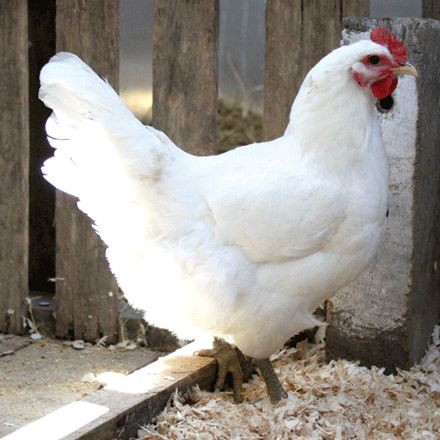
Purpose: Meat
Weight: 11 – 15 lbs
Egg Production: 150 – 200 eggs a year
This big ‘ol chicken was bred to produce meat. As its name suggests, the White Jersey Giant was bred in New Jersey in the 1880s. It never really gained popularity in the commercial markets since it offers rather poor feed conversion.
Jersey Giants may be large, but they’re gentle giants. They have the perfect temperament for a backyard flock. Their large size also keeps them from flying around. The large size of the White Jersey Giant also makes it well-suited to colder climates.
One downside of the White Jersey Giant is that large, sweet birds that don’t fly make appetizing targets for predators. Make sure you have a sizable and well-protected chicken coop and run to keep this white chicken breed safe. These chickens need about 6 to 8 square feet of space in the coop and 30 square feet in the chicken run.
White Jersey Giants consume a lot of feed. They eat between 5.5 and 7 ounces every day and take about 6 months before they’re ready to harvest. What these birds lack in feed conversion, they make up for with decent egg production and a lovely temperament. White Jersey Giants will make great additions to any backyard flock.
White Sultan
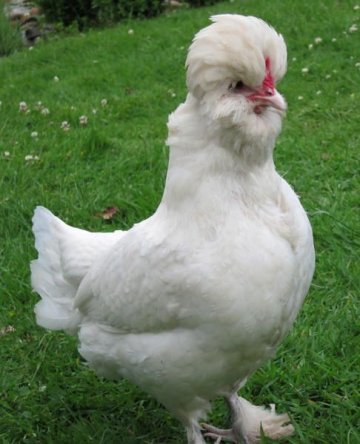
Purpose: Ornamental
Weight: 4 – 6 lbs
Egg Production: 50 – 80 eggs a year
This goofball is an ornamental white chicken breed that comes from Turkey. Their name comes from their position as the chickens kept by royalty in the Ottoman Empire. The White Sultan breed is rare today – mostly because they’re not great for meat or eggs so they’re only popular with ornamental chicken breed enthusiasts and chicken conservationists.
White Sultans are tame, docile chickens and make great pets. They do well in confinement, but you’ll need to keep their coop clean. Their puffy feet feathers can get soiled easily. This white chicken breed does well in the heat but isn’t well suited to cold climates.
If you’re going to keep these regal chickens, make sure you have a well-protected and dry area for them. They’re vulnerable to both damp conditions and predators.
White Wyandottes
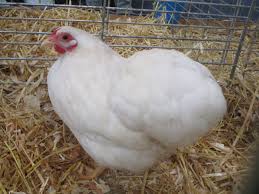
Purpose: Dual Purpose
Weight: 5 – 7 lbs
Egg Production: 150 – 200 eggs a year
The origins of this white chicken breed are hard to pin down. Part of the reason it’s so hard to find their origin is that these chickens went by several names after the US civil war including Mooney, Sebright, and American Sebright. As far as lineage goes, that’s not clear either. Some sources say that Wyandottes come from Dark Brahma and Silver-Spangled Hamburg and others say that Bredas and Cochins are in the mix as well. Regardless of their official lineage, the first Wyandotte to show up in the Standard of Perfection was the Silver-Laced Wyandotte in 1883 with the White Wyandotte debuting in 1888.
Like all Wyandottes, the White Wyandotte is great for colder climates but doesn’t tolerate heat well. This white chicken breed isn’t aggressive, but it isn’t timid either. This dichotomy gives one the impression that these birds are their own ‘person’. Think of it as a cat-like aura.
These chickens do well with a standard amount of space – about 5 square feet in the chicken coop and 10 square feet in the run. They do well with free feeding or a set schedule, but you can get away with less prepared feed if you let them forage.
Bresse Gauloise
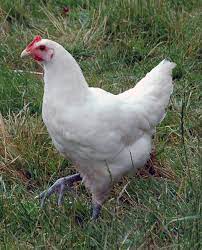
Purpose: Dual Purpose
Weight: 5 – 7 lbs
Egg Production: 200 – 250 eggs a year
The Bresse Gauloise is a 500 year-old heritage chicken breed from France and some claim this white chicken breed is the most delicious in the world. You’ll also hear this breed referred to as ‘American Bresse’. This is due to the AOC restrictions. For example – Champagne can only come from the Champagne region of France and has to meet certain standards. The style of Champagne can be made in the USA, but it has to be called American Champagne or sparkling wine. The Bresse Gauloise has AOC status as well. Bresse in the United States can be genetically identical to their French counterparts, but they’re still called American Bresse.
The Bresse Gauloise has an even temperament but they’re not particularly friendly. They’re good foragers and confinement can make them cranky. Backyard chicken keepers hoping to keep this white chicken breed for meat will want to have plenty of area to forage. In France, it’s believed their incredible flavor comes from a life of foraging and then finishing with corn and dairy.
Delaware

Purpose: Dual Purpose
Weight: 6 – 8 lbs
Egg Production: 200 – 250 eggs a year
The Delaware was bred in the 1940s for the commercial poultry market but was quickly displaced by the more aggressive-growing hybrid breeds. The Delaware was created by selective breeding of New Hampshire hens crossed with Barred Plymouth Rock cocks.
The Delaware chicken’s fall in popularity is puzzling given they’re one of the best dual-purpose breeds. They provide a decent amount of meat and are excellent egg layers. Anyone interested in homesteading and self-sufficiency should give serious thought to adding this white chicken breed to their backyard flock.
This breed is fairly tame, but not so docile that they’re easy targets for predators. Delawares are wary and are good foragers. Should you decide to keep them confined, you should have about 5 square feet in a chicken coop and 10 square feet in a run.
Conclusion
There are a lot of reasons to love white chicken breeds. White chickens are the stereotypical chicken most people think of when the word ‘chicken’ comes to mind. It doesn’t matter if you’re looking for great egg layers, meat chickens, dual-purpose chickens, or just a family pet. There’s a white chicken breed out there that’s perfect for you.
Did we forget one of your favorites? Let us know! Go to our contact page and drop us a line. We’d love to hear from you.
-
Aivituvin Wooden Chicken Coop, Large Outdoor Hen House with Nest Box Poultry Cage, Rabbit Hutch – Waterproof UV Panel…
Chicken Coops $119.99Rated 0 out of 5 -
Ogrmar Chicken Coop Large Wooden Outdoor Bunny Rabbit Hutch Hen Cage with Ventilation Door, Removable Tray & Ramp Garden…
Chicken Coops $179.99Rated 0 out of 5 -
Best Choice Products 80in Outdoor Wooden Chicken Coop Multi-Level Hen House, Poultry Cage w/Ramps, Run, Nesting Box…
Chicken Coops $199.99Rated 0 out of 5 -
zoovilla Country Style Chicken Coop Metal Nest Box with Asphalt Roof Panels
Chicken Coops $287.79Rated 0 out of 5 -
ECOLINEAR Outdoor 80” Wooden Chicken Coop Nest Box Hen House Poultry Pet Hutch Garden Backyard Cage (Chicken Coop)
Chicken Coops $151.99Rated 0 out of 5
